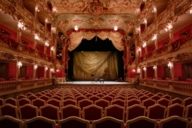
A venue that once hosted Napoleon, the Cuvilliés-Theater (Cuvilliés Theatre) in Munich’s Residenz palace is known as Germany’s finest Rococo theatre.
When the French emperor travelled to Munich in 1806 to mark Bavaria’s newly raised status to that of a kingdom, the Cuvilliés Theatre hosted two operas in his honour: “Das unterbrochene Opferfest” by Peter von Winter and Mozart’s “Don Giovanni”.
By this point, the theatre was already over half a century old. When a fire broke out in the Residenz palace in 1750, burning the entire royal theatre to the ground, Elector Max III Joseph commissioned the construction of a new opera house. When construction was completed, the theatre, which is now named after its architect François Cuvilliés, was celebrated as a “jewel of rococo design”.
The magnificent venue hosted countless elaborate productions of famous operas. Mozart’s opera “Idomeneo” even received its world premiere here in 1781. However, in the early 19th century, it entered a period of decline. At this point, the theatre was no longer reserved exclusively for the royal court but was also open to the citizens of Munich. By then, the theatre’s rococo décor was seen as a relic of times gone by.
Under the rule of King Ludwig I, the theatre company stopped performing altogether and all of the theatre’s interior fittings were removed. For a while, the room was used merely as a storage area for the neighbouring Nationaltheater.
It was King Maximilian II who restored the theatre’s status as an institution of cultural life in Munich. The monarch had the theatre renovated so that it could host classic operas. His son, the reclusive fairy-tale king Ludwig II, latched onto the spirit of the old royal theatre and enjoyed a number of performances put on exclusively for him between 1872 and 1885. These shows were known for their lavish decorations and stage technology.
The theatre was destroyed during the bombing of the Second World War. In the period between 1948 and 1951, the Neue Residenztheater (New Residence Theatre) was built on the site between the royal Residenz palace and the Nationaltheater on Max-Joseph-Platz square.
The only remnant from Cuvilliés’ theatre was the artistically carved panelling in the boxes in the auditorium, which had been transported to a safe location for storage shortly before the bombing started. In 1956, a decision was made to rebuild the Alte Residenztheater (Old Residence Theatre). The removed interior fittings were carefully renovated, joined together and installed in an area of Munich’s Residenz palace known as the Apothekenstock. For the city’s 800-year anniversary on 14 June 1958, the theatre was officially reopened with a performance of Mozart’s opera “The Marriage of Figaro”.
Now known as the Cuvilliés Theatre, the Alte Residenztheater – in its new home – is accessible from Brunnenhof courtyard inside the Residenz. With its exquisite white, red and golden décor from the 18th century, it is once again a jewel in Munich’s theatre scene.
You can find an overview of the premieres of classical spoken theatre and major music theatres here.